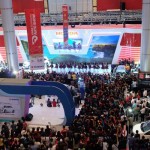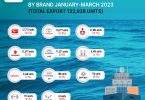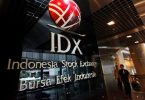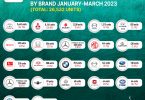
JAKARTA— Car sales in Southeast Asia from January to March 2017 grew 11 per cent. With this growth, sales became 826,545 vehicles. The largest sales growth occurred in the Philippines (20 per cent), followed by Thailand (16 per cent). Some observers see the growth as a signal of increasingly restored car market in Southeast Asia Region.
The car market in Southeast Asia has generally resurfaced in the last five years in a row. Peak sales volume occurred in March 2017. The monthly growth reached 14 per cent with 316,736 units, which occurred in six major Southeast Asian countries. They include Indonesia which has the largest market volume of ASEAN and is the second largest of car manufacturer of ASEAN. Thailand comes up as the leader of the ASEAN production volume and is the second largest market of ASEAN, followed by Malaysia, Vietnam, Singapore and the Philippines.
In Indonesia, car sales grew eight per cent in March 2017. The sales figure exceeded 100 thousand units at the time, which also reinforced indications of a recovery in market growth. The largest growth of ASEAN car sales volume in March was enjoyed by Thailand, jumping 17 per cent, even though the number is still less than Indonesia (84,801 units).
From various global principals, Japanese-made cars dominate the ASEAN auto market. They include Honda, Toyota, Nissan (Datsun), Mazda, and Mitsubishi. Especially for the Indonesian market, Daihatsu— with the production of several models whose manufacturing is done in Indonesia— is among carmakers that dominate the market. Daihatsu products in Indonesia for export are marketed with Toyota branding. Lexus, Suzuki, Hino, and UD Trucks over the last decades also include Japanese brands that have been seeing growth in Indonesia car market.
The domination of Japanese cars in ASEAN cannot be separated from their principals’ policy to build local production or manufacturing facilities— especially in Thailand and later Indonesia. This explains why Thailand dominate the production of cars in the region. All the Japanese principals build production centers in Thailand— as well as in Indonesia on a smaller scale, except for Mazda which has no manufacturing facilities in Indonesia and relies on imports from Thailand.
Outside of Japanese brands, Indonesia’s car market is also showcasing r a number of brands from other countries. They include South Korea (Kia and Hyundai), Germany (Audi, BMW, Mercedes-Benz, Porche, Vokswagen), United Kingdom (Land Rover and MINI Cooper), United States (Chevrolet, Jeep, Dodge, Chrysler), Italy (Fiat), France (Renault, Peugeot, Citrioen), and India (Tata).
Later, China— despite its failed attempt with the brand Geely and Cherry— is now trying re-enliven the Indonesian car market with the Wuling brand. They even do it without going through imports but instead directly build a manufacturing plant in Indonesia. (*)







